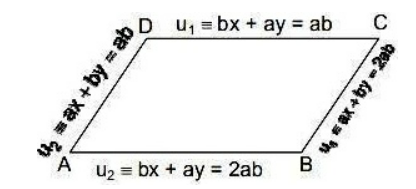In a parallelogram as shown in the figure (a≠b)

Prove that the equation of the diagonal AC is (a+b)x+(a+b)y=3ab
Step by step video & image solution for In a parallelogram as shown in the figure (a != b) Prove that the equation of the diagonal AC is (a + b) x + (a + b)y = 3 ab by Maths experts to help you in doubts & scoring excellent marks in Class 12 exams.
Updated on:21/07/2023Topper's Solved these Questions
Similar Questions
ABCD is a parallelogram. x + 2y = 3 and 2x + y = 3 are the equations of the diagonals AC and BD respectively. AC = 4 units and area of parallelogram ABCD is 8 sq. units then The length of BC is equal to
View SolutionIn a parallelogram ABCD, the bisector of ∠A bisects the line B at point X. Prove that AD = 2AB.
View SolutionThe sides AB and AD of a parallelogram ABCD are 2x−y+1=0andx+3y−10=0 respectively and C is the point (−1,−2). Find the equation of the diagonals AC.
View SolutionIf in parallelogram ABDC, the coordinate of A, B and C are respectively (1,2), (3,4) and (2,5), then the equation of the diagonal AD is
View SolutionIn a parallelogram ABCD, the bisector of ∠A also bisects BC at X. Prove that AD=2AB.
View SolutionThe diagonal BD of a parallelogram ABCD bisects angles B and D. Prove that ABCD is a rhombus.
View SolutionIn Figure, ABCD is a parallelogram. E and F are the mid-points of the sides AB and CD respectively. Prove that the line segments AF and CE triset (divide into three equal parts) the diagonal BD.
View SolutionABCD is a parallelogram where A (x, y), B (5, 8), C (4, 7) and D 2, -4). Find
(ii) Equation of diagonal BD.
View SolutionThe two adjacent sides of parallelogram are y = 0 and y=√3(x−1). If equation of one diagonal is √3y=(x+1), then equation of other diagonal is
View SolutionLet ABCD be a parallelogram the equation of whose diagonals are AC:x+2y=3; BD: 2x + y = 3. If length of diagonalAC=4 units and area of ABCD=8 sq. units. Find the length of the other diagonal is a. 10/3 b. 2 c. 20/3 d. None of these
View Solution